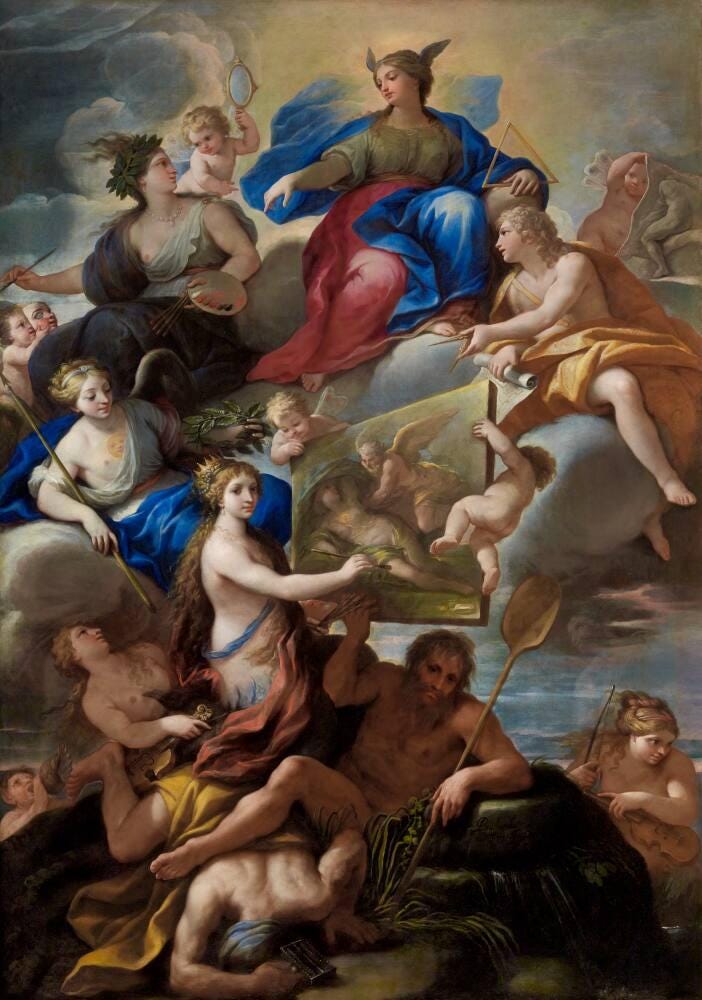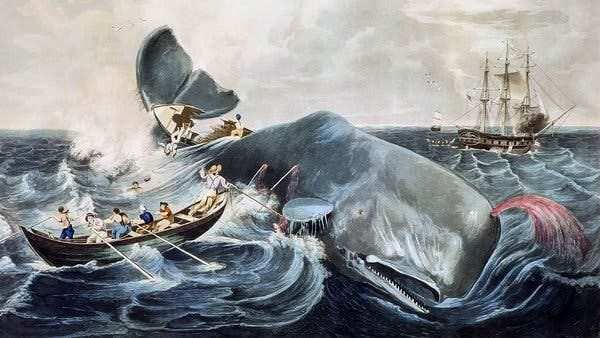Why Start with Plot?
I always do when I'm teaching, even if I don't when writing.
*Today is the last day to register for my 4-week webinar “Fundamentals of Fiction” for the WLT Summer Writing Retreat (Mondays in July, 6:30-9:30 CST). Register here by 5pm today if you’d like to join.* In the meantime, I thought I’d share a bit about why I always start my fiction classes with a breakdown of plot and three-act story structure, even when we go on to discuss other things.
First off, I’m just filling what seems to be a hole in many writers’ knowledge. Most fiction MFA programs simply do not teach plot and story (if you know of exceptions, drop them in the comments!), and I find the available books helpful, but not comprehensive.
Paolo de Matteis, Allegory of Knowledge and the Visual Arts Crowning Parthenope, the Siren of Naples, c. 1685. This has nothing to do with plot, I just saw it at the MFAH this weekend and I love a painting within a painting.
At the same time, I’m always sympathetic to students who are worried that learning these structures will cramp their style, hamper their creativity, and force a formula on their work that simply doesn’t fit. Although I’ve written thrillers, not every book I write has a high-stakes genre plot; moreover, I have a PhD in English and read plenty of literary and experimental fiction. So why do I not only start with story structure, but continue to loop back to it when discussing character, pacing, scene structure, theme, and other fundamentals of fiction?
Here are some of my usual answers. I hope they help, not just in deciding whether to take a class with me, but in general, as you think about what writing skills you’d like to add to your repertoire.
The structures I teach are not prescriptive; they’re descriptive.
In other words, they’re not here to tell you what you should do; they’re here to tell you what has worked in the past, and—most importantly—to get you thinking about why they work. I don’t teach Joseph Campbell’s The Hero with a Thousand Faces (1949) for various reasons, but even I have to admit it’s the progenitor of most of the plot books I teach, and it’s based on observation (however flawed), not prescription. There are certain structures that just seem to work, for whatever reason, and have been around a long time in our part of the world.
The structures I teach are not totalities; they’re diagrams.
The number of different choices represented by any given novel are prodigious. No totalizing structure could possibly account for them all. Even if you could isolate “story” as one piece apart from the others (which I’m not sure you can), there are far too many elements and relationships ever to represent them in a system that’s usable. That’s why there are so many plot books out there. None are, in my opinion, the “one true book”; they’re just different ways of conceptualizing a data set too vast to represent in its entirety. Think of pie charts, bar graphs, and other helpful diagrams that present data in ways that are useful for different applications. I am primarily interested in the relationships, not just between plot points, but between story and character, story and theme, and story and prose style. I teach a variety of texts that, when layered together, have helped me ferret out those relationships—and frequently use them to get unstuck.
The structures I teach are not universal; like all the elements of fiction, they are particular to a time and a place.
Contrary to what lots of storytelling books will tell you, no single plot structure is common to all cultures, much less “hard-wired” in the human brain. To the extent that Western three-act structure has achieved some kind of global hegemony, it probably has more to do with the dissemination of mass culture via Hollywood movies than with anything universal. These things are memes, not scriptures. (See the “barking dog” phenomenon for an example of a trope that exists across genre lines and the high/low culture divide, yet is clearly not universal!)
Are three-act structure, the “beat sheet,” character arcs, story-as-change, and other “fundamentals” of modern fiction tools of colonialism? Are we duty-bound to contravene them with experimentalism and fragmentation? Should we all be Lucy Ellsworth?? Maybe! That’s up to you to decide! But keep in mind that modern-day literary fiction is also a historical phenomenon.** Close reading was a New Criticism hobbyhorse popularized in the Iowa Workshop in the post-WWII era. None of these standards of craft are “pure.”
The structures I teach are already in your brain; analyzing them will help you both deploy and deviate from them more effectively.
The absolute best reason for learning these structures, whether you want to use them or escape them, is that you already know them. They have colonized your brain along with the world. You think in three-act structure! You’ve been reading and watching and absorbing it since you were born. Goodnight Moon has it. Green Eggs and Ham has it. Pride and Prejudice has it. (In fact, I think one of the underplayed secrets of Jane Austen’s influence is that she codified it and tied it to the emergent marriage plot, but that’s another story.) Jane Eyre has it. Dangerous Liaisons has it. Great Gatsby has it. Even Moby-Dick has it. All of these books have other things going on—sometimes a LOT of other things. But they also have stories with a recognizable arc, and they hit many if not all of the beats that correlate with the beat sheet. You may not be hard-wired to respond to these structures, but you are certainly culturally conditioned to respond to them. You are using them whether you know it or not.
So…why learn it if you know it? Just as learning parallel structure helps you write a better sentence, just as learning music theory helps you compose a sonata, so learning narrative structure helps you write a better book, whether you decide to adhere to it or depart from it. Not only will this help you diverge from audience expectations intentionally and with purpose, but it will also help you recognize when you are recreating cliches. One of my biggest gripes about literary fiction, when I was reviewing for the Chicago Tribune, was how often it recreates seasoned tropes while presenting them as original. Know what you’re ripping off, and you will better know how to riff on and improve it! To quote Bruce Lee, “Learn it all, and forget it all.” But forgetting is not the same as never knowing.
AND FINALLY…..
Formulas get a bad rap.
Rocket scientists use them to go to space, you know? A good formula is airtight, yet infinitely flexible. They can be beautifully simple or extremely complex. Formulas aren’t bullies; they don’t tell you what variables to choose. They tell you, with wonderful economy, the relationships between things. Proportion. Scale. Movement. None (and certainly none in storytelling) can encompass The Big Everything all on their own, but layered over each other like melodies and harmonies, they can create gorgeously satisfying compositions. With enough of them, maybe we could even describe the universe.
And a novel is a little universe. It’s a complete system unto itself, and within its scope, it contains nearly infinite complexity. Every word, phrase, sentence and paragraph, every character and scene and arc, has a purpose. Depending on the purpose you’re aiming for, there are proportions, scales, movements that you’ll want—need!—to know. There are no laws here. It’s not a given that a novel must have 16 beats, or 100 scenes, or even a single protagonist. Novels exist to serve different purposes. But those golden ratios and pleasing harmonies are out there, and we might as well learn them.
Dorothea Tanning, Self-Portrait, 1944. It’s a big world out there.
Will learning and applying these structures—formulas, even!—get you an agent and a book deal and a movie option? Well, hell if I know! I’d never make a promise like that. But I do most sincerely believe that knowing them will make your book better. And, if personal experience is any guide, they will almost certainly help you finish it.
Want to talk more about this stuff, but can’t make the “Fundamentals of Fiction” webinar in July? I am also teaching in-person and online classes this fall, including my 12-week “Draft Your Novel, Act I: Beginnings” class. Subscribe to get updates on all my classes, or email me at amyegentry@gmail.com for details.
*I don’t care much about the difference between those plot and story, because 90% of the time it doesn’t matter. Where the difference is important, I’ll make the effort.
**If you’re interested in the rise of the “art novel,” creative writing, and literary fiction, and you can tolerate academic prose, see Mark McGurl’s The Novel Art: Elevations of American Fiction after Henry James (2001) and The Program Era: Postwar Fiction and the Rise of Creative Writing (2011). Both are great.





I love the analogy of story structure as a golden ratio!